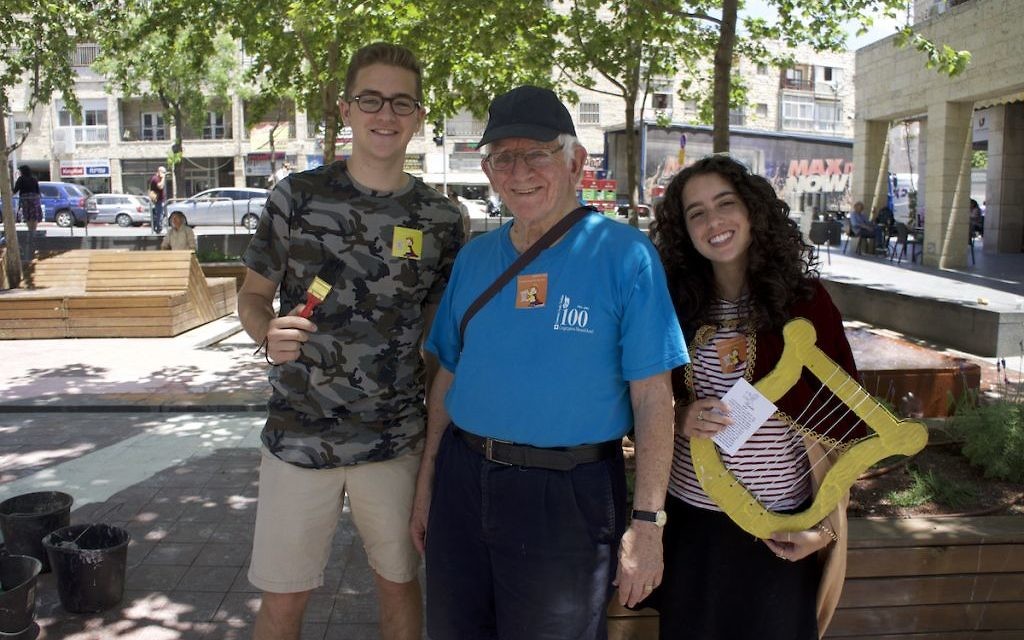David Moss Works His Magic in Jerusalem
A downtown group project creates an intergenerational Atlanta connection.

Well-known Jewish artist David Moss, who has taught and spoken in Atlanta on numerous occasions, possesses the ability to innovate in a multitude of fields. By accident, his most recent project provided me with a meaningful Atlanta experience.
I went to view Moss’ project in downtown Jerusalem, where he was working with a small group of young people from Yeshivat Torah V’Avodah, a gap-year program for students between high school and college from the United States and Canada.
Last year under his supervision, the students cleaned and weeded an overgrown site in Jerusalem and helped transform it into a wonderful community park for the neighbors, complete with lovely, symbolic sculptures and sitting and meeting spaces based on carved biblical verses about brotherhood and community.
Get The AJT Newsletter by email and never miss our top stories Free Sign Up
This year their project consisted of a three-day happening in Davidka Square in downtown Jerusalem.

I spoke to one of the participants, Aaron Butler, who asked where I was from in the United States.
When I said Atlanta, he told me his father was from Atlanta and his grandparents still live there. I asked whether Eleanor Jean Butler and Joel Butler were his grandparents, and he said yes and asked if I knew them.
I told him, “Your great-grandfather was Henry Leff, who played the harmonica and was at the Breakfast and Davening Club at Ahavath Achim Synagogue every Sunday. Your great-grandmother was Ida Rosenberg, whose younger brother and his wife I know well.
“The Geffen family is in debt to your great-great-grandfather Jacob Butler because in 1957 he filmed the community dinner in honor of my grandfather and grandmother, Rabbi and Sara Hene Geffen. We have that film, and it was digitized by our grandson, Ori Burg.”

Together we stood at Davidka Square on Jaffa Road, now a light railway stop built by the company Alstom Israel, of which our son Avie Geffen is the CEO. What a series of coincidences.
But in a way, creating such connections is exactly what this project was meant to do.
I asked Moss what the group was doing.
“Our group this year was given access to the bustling central Davidka Square in downtown Jerusalem. It’s at a major axis of pedestrian and vehicular traffic, with a busy stop for the light rail,” he said. “Our group analyzed the park and was struck by two things that became the focus of our work.”
He said the diversity of the passers-by was “astonishing — from every community in Israel, every religion and religious persuasion, and tourists from all over the world.”
The large, bustling Abraham Hostel is on the square.
“But then we were struck by the fact that they all seemed to be living in their own, separate, isolated shells,” Moss said.
The creative challenge was how to encourage people to meet, to interact, to talk and to learn from one another. Quite a task, Moss pointed out, but he made it doable.

During the intense multiday intervention/happening, the students painted colorful paths in ecologically friendly earth paints across the whole park. The paints were provided by project co-sponsor Muslala, a perceptive group of urban artists.
Moss stressed “how these paths of intersection helped the visitors meet and interact. We created a character, Davidka, little King David, who exchanged her cannon for a harp and invited folks to help paint and talk to each other. Stickers with questions helped to motivate passers-by to speak deeply, frankly and heartfully.”
The questions — such as “Who was the most influential person in your life?” and “What life lesson can you share?” — prompted reactions.

Like all of Moss’ group projects, this one inspired the students to learn how real art happens. They started with a real challenge and imagined, conceived and designed a work of meaning and beauty.
The group had its share of real-life challenges along the way. In the Moss approach, the unexpected is an essential part of design and creation.
Moss created a world-renowned illuminated haggadah and visited Atlanta to speak about what he had done to craft this ancient book with a unique approach. In his younger years, he revived the art of the illuminated ketubah. I personally know that is not enough for him.
He was on the design team for the award-winning Yavneh Academy in Dallas. He helped design the Hillel building at UCLA and the UJA-Federation building in New York.
He believes his mission is to devise fresh, creative means to give Jewish ideas, texts and values expression through art. With this current program, David has done it again.




comments